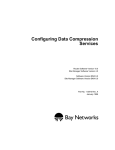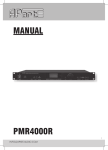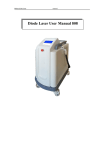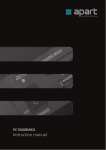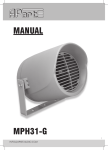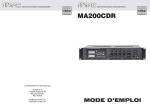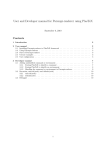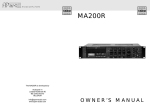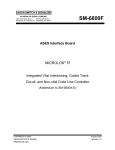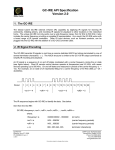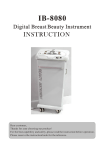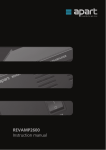Download MANUAL NETKIT-IR/-RS
Transcript
MANUAL NETKIT-IR/-RS 1 [email protected] Introduction The APart Netkit product family is designed to quickly connect almost any electrical device with RS232 or IR control to a network and comes with a choice of wired TCP/IP connectivity to infrared (IR) or serial (RS232) equipment. The IR units include 3 configurable in/outs and all units (IR and RS) include built-in IR learning. An embedded web server allows easy configuration from any web browser. Now it is possible to design and integrate a low-cost custom control system for APart products and other devices with serial or infrared control possibilities. The NETKITIR and NETKIT-RS allow easy integration with PC, Mac, iPhone/iPod/iPad and Android devices via freely available software applications. This manual describes the various features from our Netkit units. You can use third party software to operate the Netkits via home control units, tablets or smartphones. An example is described in chapter 7 of this user manual. How to get started Connect a standard RJ45 network cable and the power supply to your Netkit unit. Connect the other end of the network cable to your wireless router or IP network. In its default configuration, the Netkit models use DHCP to automatically obtain an IP address from your network router. To determine the IP address, download the Netkit Help application from our website. Run the program from a Windows PC that is connected to the network. The Netkit Help application listens for Netkit units multicast beacons and displays the Netkit IP address and other details within one minute. If a DHCP server is not present, defaulted Netkit units will reside at IP 192.168.2.100 Each Netkit unit has an internal IR learner. To use it, download the latest Netkit Learn application from our website. Once connected to your Netkit Learn program, simply point your infrared remote at the small hole located to the right of the power connector (see figure 1) and press any button you want captured by Netkit Learn. Netkit units’ configuration can be reset to factory defaults by inserting a metal pin (like a paper clip) into the small opening located to the right of the power connector (see figure 1). Do not push the paper clip in deeper than approximately 2 WWW.APART-AUDIO.COM 3 NETKIT-IR 1 4 1. 2. 3. 4. 5. 2 figure 1 RJ45 connector Power supply connector IR learning eye/reset switch IR module RS232 module 3 NETKIT-RS 1 5 2 3 mm. The LED’s on the front of the Netkit unit will rapidly blink in unison, indicating a reset. Use a light touch when resetting your Netkit unit, as force may damage your Netkit hardware irreparably. For easy programming and Netkit setup, four dedicated applications are available for download on our website. You will need a Windows PC connected to a network via a router and at least one available network connection on the router. Set the router to DHCP mode for easy discovery of the Netkit units. With the configuration tools, you can easily assign fixed IP addresses if necessary. • Netkit help: this tool searches for Netkit units in your network and allows easy access, hardware and network specific configuration of the units. Use this tool first! It will make further programming easier. • Netkit convert: converts hexadecimal commands to commands in Netkit specific format and vice versa. • Netkit learn: capture infrared commands and save them in Netkit specific, hexadecimal or uncompressed formats. • Netkit test: test your commands before using them in your specific application. 3 [email protected] Netkit application programming interface. Version 1.0 1. The Netkit modular design concept The Netkit product family’s modular design provides a variety of capabilities. Each module provides a particular function: power and network connections, with either infrared (IR) or digital connections (RS232). A module may also support one or more connectors of the same type. For example, an IR module has three independent IR connectors; whereas, a serial module has only one serial RS232 connector. This is due to the fact that the number of connectors a module can support is dictated by its 1.5 inch physical width. It is important to understand that a module’s address is determined solely by its physical position within the Netkit enclosure. Each module occupies 1.5 inches of front panel space. At power on, module addresses are assigned starting with “0” for the left-most module (containing the network and power connectors) and increasing sequentially to the right until all module addresses are assigned (see figure). This presents a consistent programming interface as additional modules are added. A connector’s address is its position within a module, starting at 1 on the left, and increasing sequentially as you move to the right. A complete connector address includes the module address and the connector location in the module, separated by a colon. One IR module is contained in the Netkit-IR (figure 1). The first IR connector on the IR module has an address of 1:1, whereas the third IR connector has an address of 1:3. IR Connectors: Support for an IR blaster is enabled on the third (*:3) IR connector on an IR module. This can be configured via command, or must be selected via the internal webserver. Attempts to configure connectors other than *:3 as an IR blaster will result in a returned error message. The IR blaster is available on request only. Contact your local dealer for more information. 4 WWW.APART-AUDIO.COM 2. Configure the IP Address The TCP/IP connected Netkit unit is set by default to use DHCP to automatically obtain an IP address from the router. To determine the IP address of a Netkit using DHCP, run the Netkit Help Utility found on our website. Within 30 seconds of power up, the Netkit unit will announce its model type, IP address, and MAC ID via a network wide beacon broadcast, which Netkit Help application displays. The Netkit unit will also periodically announce its IP address at intervals between 10 and 60 seconds while powered up to maintain up-to-date Netkit Help display information. The Netkit Help display may be refreshed from the View tab option. 3. Discovery Beacon The Netkit unit features a beacon message that can assist in locating Netkit units on the network. The beacon is a UDP packet sent to the multicast IP address 239.255.250.250 on UDP port number 9131. Any system listening to this address and port will receive the periodic beacon message. The message is sent shortly after power on and then at random intervals of 10 to 60 seconds thereafter. The UUID value contains the unique MAC address of the Netkit unit which is also the name registered with the DHCP server. 4. Command and Data Structure Communication with the Netkit is accomplished by opening a TCP socket on Port 4998. All commands and data, with the exception of serial (RS232) data, are communicated through Port 4998. Port 4998 is used for such things as Netkit status, IR data, and reading digital input states. All information, with the exception of serial data, is communicated by comma delimited ASCII text strings terminated by a carriage return. Serial data is communicated via Ports 4999 and above. 5 [email protected] 5. Command Set Commands are initiated by a short ASCII string representing the command type. Typically, physical address and data information will follow. The structures of Netkit commands are described in the following sections. Text enclosed in brackets (<text>) must be substituted by its ASCII definition. Multiple ASCII choices are divided by separator ( | ) characters. Note: Commands are case sensitive. Example: The network settings are queried with the get_NET command: get_NET,<connectoraddress>(enter) where; <connectoraddress> is 0:1 (network module address) The command ASCII string sent to the Netkit is: get_NET,0:1(enter) 5.1. General Commands getdevices This Netkit command is used to determine installed modules and capabilities. Each module responds with its address and type. This process is completed after receiving an endlistdevices response. Sent to Netkit: Getdevices(enter) (query for modules and capabilities) device Sent from each Netkit module in response to getdevices: device,<moduleaddress>,<moduletype> (one sent for each module) where for Netkit products; <moduleaddress> is |0|1| <moduletype> is |ETHERNET|3 IR|1 SERIAL| All modules are included in the response followed by endlistdevices(enter) The following are the possible Netkit IR responses to a getdevices command. device,0,0 ETHERNET(enter)device,1,3 IR(enter)endlistdevices(enter) for IP to three infrared device,0,0 ETHERNET(enter)device,1,1 SERIAL(enter)endlistdevices(enter) for IP to one serial 6 WWW.APART-AUDIO.COM getversion Sent to Netkit: getversion(enter) Sent from Netkit in response to getversion: <textversionstring>(enter) Where: <textversionstring> is the version number ASCII string Sent to Netkit: getversion,<moduleaddress>(enter) Where: <moduleaddress> is |0|1| Sent from Netkit in response to getversion: version,<moduleaddress>,<textversionstring>(enter) get_NET This command will retrieve the current network settings and return a comma delimited string with the network settings. Sent to Netkit: get_NET,0:1(enter) Sent from Netkit in response to get_NET command: NET,0:1,<configlock>,<ipsettings>,<ipaddress>,<subnet>,<gateway> Where: <configlock> |LOCKED|UNLOCKED| <ipsettings> |DHCP|STATIC| <ipaddress> is the assigned network IP <subnet> is the network subnet mask <gateway> is the default network gateway unknowncommand An unknowncommand response will be sent by the Netkit when a command is not understood. This can happen if, for example, a connector is set up as a digital input and the command requested is sendir. Sent from Netkit in response to unknown commands: unknowncommand, [error code](enter) Note: Definitions are contained in the Error Codes table in section 5.2 Serial Connect Netkit serial communication is bi-directional, RS232 communication. All communication is 8 data bits and one stop bit. Parity, hardware flow control, and baud rate are set through the Netkit internal web page or via configuration command, with baud rate enabled up to 115.2 Kbaud. All serial data is passed through without interpretation or conversion via an assigned, unique IP port. The Netkit serial connector is assigned to IP Port 4999. If a serial connector is not configured correctly, buffer overflows (indicating data 7 [email protected] loss), or parity errors will occur. Any errors will be captured and presented on the Serial web page to aid in proper setup. Settings such as Serial Multiconnection Mode, 7 data bit mode, or 2 stop bit mode are only accessible from the Serial web page. 5.2. Serial Commands set_SERIAL This command allows for configuration of the Netkit serial. Sent to Netkit: set_SERIAL,1:1,<baudrate>,<flowcontrol>,<parity>(enter) where: 1:1 is the Netkit serial connector’s address <baudrate> is |115200|57600|38400|19200|14400|9600|4800|2400| 1200| <flowcontrol> is |FLOW_HARDWARE|FLOW_NONE| <parity> is |PARITY_NO|PARITY_ODD|PARITY_EVEN| Example: set_SERIAL,1:1,38400,FLOW_HARDWARE,PARITY_NO(enter) This command string will set the Netkit serial connector to operate at 38400 baud with hardware flow control and no parity. get_SERIAL This command will retrieve the current Netkit serial settings. get_SERIAL,1:1(enter) SERIAL Sent from Netkit in response to set_SERIAL and get_SERIAL. SERIAL,1:1,<baudrate>,<flowcontrol>,<parity>(enter) 8 WWW.APART-AUDIO.COM Note: RS232 Multiple Connection Mode This mode enables four simultaneous TCP sockets to Netkit port 4999. In this mode, each socket can transmit data out the serial connector on a packet-bypacket basis. Each packet received for port 4999 will be transmitted completely before another packet (from the same or different socket) is transmitted out the serial connector. This ensures complete commands can be received and understood by the serially connected device. The only requirement is for each entire command(s) to be sent in one TCP packet. All serial data received by the serial connection is transmitted to all OPEN TCP sockets on port 4999, allowing each connected application to maintain and update serial device status. This mode can only be enabled or disabled from the Serial settings web page. 5.3. IR Commands 5.3.1 General IR Commands set_IR This command allows configuration of each IR connector to the desired mode of operation. The possible modes are IR output, sensor input, sensor notify (see 5.3.2), IR blaster, and LED lighting (see 5.3.3). The IR blaster is only supported on the third IR connector. Sent to Netkit: set_IR,1:1,<mode>(enter) where: <mode> is |IR|SENSOR|SENSOR_NOTIFY|IR_BLASTER|LED_LIGHTING| Example: set_IR,1:3,LED_LIGHTING(enter) This will set the third IR connector to LED lighting mode. get_IR This command will retrieve the current mode setting for a designated connector. Sent to Netkit: get_IR,1:1(enter) for the 1st IR connector get_IR,1:2(enter) for the 2nd IR connector get_IR,1:3(enter) for the 3rd IR connector Sent from Netkit in response to get_IR query: IR,1:1,<IR|SENSOR|SENSOR_NOTIFY|IR_BLASTER|LED_LIGHTING>(enter) 9 [email protected] stopir A stopir command is used to halt IR transmission. Any remaining <repeat> counts will be discarded. A stopir command sent to a connector configured as an input will return an error message. An IR transmission halted with the stopir command will return a stopir response. Furthermore, if an IR command is halted before its completion by another connection, the originating IR connection and the connection sending stopir will both receive a stopir response. If stopped, the originating connection will not receive a completeir response. Sent to Netkit: stopir,1:1(enter) to stop the 1st IR connector transmission stopir,1:2(enter) to stop the 2nd IR connector transmission stopir,1:3(enter) to stop the 3rd IR connector transmission Sent from Netkit in response to stopir command: stopir,<connectoraddress>(enter) where; <connectoraddress> is as defined in stopir command A stopir command always returns a stopir response regardless if the connector is idle or an IR transmission is actually halted. A stopir response means only that the stopir command was successfully sent to the Netkit, and any transmission has been halted from the designated <connectoraddress>. busyIR A busyIR response occurs when an IR command is received by a connector that is already sending an IR transmission. If multiple IP connections are present (i.e. from multiple iPhone users) there is a possibility of an IR transmission not being transmitted. This occurs when an IR command is sent to the same IR connector from another IP connection, and will cause a busyIR response. A busyIR response does not occur if the two IR commands are executed on different IR connectors. Sent from Netkit in response to an attempt to interrupt IR transmission by another IP connection or socket: busyIR,<connectoraddress>,<ID>(enter) where: <connectoraddress> is the busy connector <ID> is |0|1|2|…|65535| (ID is specified in sendir command) Note: The busyIR response is returned to the originator of the unexecuted IR command. A command to stopir will only return the stopir response. At no time will a command of stopir return a response of busyIR. 10 WWW.APART-AUDIO.COM 5.3.2 Sensor Notify Netkit IR connectors can be configured as Sensor Notify. Use of the set_IR command to enable Sensor Notify status will enable default settings. This will set the UDP broadcast port to 9132 with a timer of 10 seconds. Configuration of Sensor Notify parameters (port and timer) must be changed by way of the IR settings web page. There, both the UDP port and timer settings can be changed to suit network and software specifications. Sensor notifications are broadcast by way of UDP packet, sent in timed increments specified by the web configuration (in seconds), and also sent when a sensor state changes, notifying anything listening to the specified UDP port by way of an immediate network broadcast. If the timer value is set to 0, sensor notifications will broadcast only when the sensor state changes. Sensor Notify UDP broadcast packet contents are as follows: sensornotify,<connectoraddress>:<inputstate>(enter) where: <connectoraddress> is as defined in section 1. <inputstate> is as defined in 5.3.2 5.3.3 LED Lighting This connector state allows for pulse width modulated control (at 120Hz) of LED lighting. Wiring for the 3.5mm connector must be connected so that the Dim line comes in on the tip, and the Dim Return line is on the base. The necessary command syntax and parameters for changing the pulse width carried on the connector are located below: Sent to Netkit: set_LED_LIGHTING,<connectoraddress>,<% intensity>,<linear ramp>(enter) where: <% intensity> is the target percentage light intensity upon completion |1100| <linear ramp> |0-10| is the rate of change per unit time; 1 being the slowest and 10 being the fastest. A ramp of 1 will go from 0% to 100% in about 10 seconds, a rate of 10 will take about 1 second, while a ramp of 0 will change the value instantly. Sent from Netkit in response to set_LED_LIGHTING: LED_LIGHTING,<connectoraddress>,<% intensity1>,<% intensity 2>(enter) where: <% intensity1> |0-100| is the current lighting intensity <% intensity2> |0-100| is the target lighting intensity upon completion 11 [email protected] The state of the LED Lighting connector can be polled for its intensity with the get_LED_LIGHTING command. Note that the LED_LIGHTING response will always return with two <% intensity> values. If the connector is not currently changing the lighting intensity, then both <% intensity> levels will be the same value. Sent to Netkit: get_LED_LIGHTING,<connectoraddress>(enter) Sent from Netkit in response to get_LED_LIGHTING: LED_LIGHTING,<connectoraddress>,<% intensity1>,<% intensity 2>(enter) where: <% intensity1> is the current lighting intensity <% intensity2> is the target lighting intensity upon completion 5.3.4 Dedicated LED Lighting Modes Netkit IR units now have two new Dedicated LED Lighting modes, which are the first Netkit functions using more than one connector in tandem. In the Single Input LED mode, the second connector is configured as a lighting control sensor while the third connector is configured as a LED Lighting connector. When enabled, standard set_LED_LIGHTING commands function properly when sent to the LED Lighting connector. This works alongside the lighting control sensor, which monitors the circuit between the tip and the base of the 3.5mm connector. When a momentary contact is made, the lighting control sensor toggles the lighting level between on and off. When held for a long press, the lighting control sensor will dim or elevate the lighting level for as long as the contact is closed. The long press function toggles between elevating light levels and dimming them. In the Dual Input LED Mode, the first two connectors are configured as lighting control sensors, while the third connector is configured as a LED Lighting connector. When in this mode, standard set_LED_LIGHTING commands function properly when sent to the LED Lighting connector. This mode works alongside the lighting control sensors, which monitor the circuit between the tip and base of each respective connector. Connector 1 is the down function sensor. When a momentary contact is made, this sensor turns the LED Lighting connector to 0%. When held for a long press, the lighting control sensor will dim the lighting level for as long as the contact is closed or until it reaches 0 percent (%). Connector 2 is the “up” function sensor. When a momentary contact is made, this sensor turns the 12 WWW.APART-AUDIO.COM LED Lighting connector to 100 percent. When held for a long press, the lighting control sensor will elevate the lighting level for as long as the contact is closed, or until it reaches 100 percent. 5.3.5 IR Structure An IR, or infrared transmission, is created by sending an IR timing pattern to the Netkit. This pattern is a collection of <on> and <off> states modulated with a carrier frequency ( ƒ ) which is present during the <on> state. A carrier frequency is typically between 35 to 45 KHz with some equipment manufacturers using as high as 500 KHz. The length of time for an <on> or <off> state is calculated in units of the carrier frequency period. For example, an <off> value of 24 modulated at 40 KHz produces an <off> state of 600μS, as calculated below. A period is 1 /ƒ or 1/40000 or .000025 seconds or 25μS, and a value of 24 periods is 600μS IR timing patterns typically have a long, final <off> value (or rest state) to ensure the next IR command is interpreted as a separate IR transmission. 5.3.6 Sending IR Control of IR devices is accomplished through use of the sendir command. Since IR commands may take up to 100mS to complete, the Netkit provides a completeir acknowledgment to indicate when it is ready to accept the next IR command for the connector in use. Sendir Sent to Netkit: sendir,<connectoraddress>,<ID>,<frequency>,<repeat>,<offset>,<on1>,<o ff1>,<on2>,<off2>,….,<onN>,<offN> (where N is less than 260 or a total of 520 numbers) where: <connectoraddress> is as defined in section 1. <ID> is |0|1|2|…|65535| (1) (for the completeir response, see below) <frequency> is |15000|15001|….|500000| (in hertz) <repeat> is |1|2|….|50| (2) (the IR command is sent <repeat> times) <offset> is |1|3|5|….|383| (3) (used if <repeat> is greater than 1, see below) <on1> is |1|2|…|65635| (4) (number of pulses) <off1> is |1|2|…|65635| (4) (absence of pulse periods of the carrier frequency) [email protected] 13 (1) The <ID> is an ASCII number generated by the sender of the sendir command, which is included later in the completeir command to confirm completion of each respective sendir transmission. (2) The <repeat> is the number of times an IR transmission is sent, if it is not halted early via a stopir or another IR command (see section 5.4). Values above 50 are accepted, but IR commands are sent only the maximum 50 times. In all cases, the preamble is only sent once (see <offset> below). (3)An <offset> applies when the <repeat> is greater than 1. For IR commands that have preambles, an <offset> is employed to avoid repeating the preamble during repeated IR timing patterns. The <offset> value indicates the location within the timing pattern to start repeating the IR command as indicated below. The <offset> will always be an odd value since a timing pattern begins with an <on> state and must end with an <off> state. (4) Since IR transmissions ends in an <off> condition, there must be an equal number of <on> and <off> states. Also, every <on> and <off> state must meet an 80μS minimum time requirement for the Netkit to work properly. Example: With a carrier frequency of 48 KHz, the minimum value for <on> and <off> states is calculated below. <off> min = <on>min ≥ 80μS * ƒ = 80μS * 48KHz = 3.84 For proper Netkit operation, all <on> and <off> values in the timing pattern must be 4 or higher. All of the conditions above must be met for valid sendir commands. When a variable is missing or outside the accepted range, an unknowncommand will be sent by the Netkit. As an exercise, the sendir commands below will trigger a Netkit unknowncommand response. sendir,5:3,3456,23400,1,1,24,48,24,960(enter) Netkit module 5 does not exist Response: ERR_0:0,002 sendir,1:2,23333,40000,2,3,24,48,24,48,960(enter) not an equal number of <on> and <off> Response: ERR_1:2,010 sendir,1:3,0,40000,2,2,24,48,24,960(enter) <offset> is an even number Response: ERR_1:3,007 IR compressed format assigns the first 15 unique <on><off> pairs capital letters (i.e. A,B,C, etc.) to represent them. In the event that a pair is used in many places inside an IR command, commands can be written with the capital letter in place of the designated pair without being offset by commas. 14 WWW.APART-AUDIO.COM Example: The simple IR command sendir,1:2,2445,40000,1,1,4,5,4,5,8,9,4,5,8,9,8,9(enter) can be shortened with this feature: (“4,5” is assigned A, and “8,9” is assigned B) sendir,1:2,2445,40000,1,1,4,5A8,9ABB(enter) Both commands are syntactically correct, are accepted by the Netkit, and will transmit an identical IR command. completeir All successful sendir commands are acknowledged with a completeir response from the Netkit after completion of the IR transmission. The completeir response associates with the sendir command through an <ID>. When utilized, the <ID>s can provide a unique identifier to determine which IR transmission has completed. Sent from Netkit in response to successful sendir: completeir,1:1,<ID>(enter) for the 1st IR connector completeir,1:2,<ID>(enter) for the 2nd IR connector completeir,1:3,<ID>(enter) for the 3rd IR connector where: <ID> is |0|1|2|…|65535| (ID is specified by originating sendir command) Example: A few simple IR commands are shown below: The following will send the IR timing sequence illustrated in figure 4.2a to the 2nd IR connector on the Netkit shown in Figure 1. Sent to Netkit: sendir,1:2,2445,40000,1,1,4,5,6,5(enter) Sent by Netkit in response to sendir: completeir,1:2,2445(enter) In the next example, the following two IR commands will send the same IR timing pattern. Below are two ways to send the same simple IR timing pattern of 24,12,24,960 four times with a preamble of 34,48: sendir,1:2,4444,34500,1,1,34,48,24,12,24 ,960,24,12,24,960,24,12,24,960,24,12,24,960(enter) sendir,1:2,34,34500,4,3,34,48,24,12,24,960(enter) Acknowledgments for above IR commands are: completeir,1:2,4444(enter) completeir,1:2,34(enter) Although the same command is sent four times by both sendir commands, the <ID>s are different, and therefore cannot be considered the same command. The second IR command structure is the recommended method, avoiding long commands and allowing repetition of the command to be halted if requested. 15 [email protected] 5.3.7 Smooth Continuous IR Commands A general discussion is necessary to better understand how smooth continuous IR commands are executed by the Netkit. This desirable feature is utilized for smooth volume control or repeating an operation without the appearance of choppy actions. The approach of sending an IR command with very large repeat counts and stopping it upon request will work, but can lead to undesirable incidents. Consider the scenario of large repeat count IR command for raising the volume in a smooth fashion. The command works properly until the connection is broken. A repeating IR command is sent, volume continuously increases, then the controlling iPhone is unexpectedly dropped. The volume continues to rise (possibly damaging equipment) until a stopir command is ultimately received. The Netkit solution is to limit the repeat count. Hence, to create a smooth IR operation, the Netkit resets the IR repeat count each time the identical IR command (from the same IP connection) is resent. This method will not interrupt and restart the IR command, but reset the IR repeat count back to the original value. Example: If the IR repeat count is set to 5, and the IR command has transmitted 3 times, receipt of the same command causes the repeat count to be reset back to 5. This process can continue indefinitely while a volume button is held down to create a smooth operation. However, at no time can the command repeat more than 5 times after the button is released or an IP connection is inadvertently lost, preventing a potentially serious issue. By selecting an appropriate <repeat> value, the need for a stopir command is eliminated. In this example the volume continues to increase smoothly by retransmitting repeated IR commands due to the volume button being pressed. As long as the next repeated IR command is received before the previous command finishes, smooth operation is realized. By choosing a low repeat value, the volume increase will stop when the volume button is released. Also, proper IR operations happen even with unintended network delays due to traffic or WiFi connectivity. In this unlikely event, only small hesitations will be experienced during IR operation. In the event that the identical command is not received before the original command is finished, the command will be registered as a brand new command, and is sent as such. The command in question will operate functionally the same, but delays between commands may be evident when used in this way. Increasing the <repeat> value will likely eliminate these discrepancies. 16 WWW.APART-AUDIO.COM 5.3.8 IR Learning Each Netkit unit contains an on-board IR learner, which is located in the small hole located below and to the right of the power connector. IR Learner Mode is enabled by implementing the get_IRL command. IR learning mode cannot be activated if the unit is configured to control LED lighting. get_IRL Sent to Netkit: get_IRL(enter) Sent from Netkit in response to get_IRL: IR Learner Enabled(enter) Once enabled, the Netkit sends an uncompressed Apart-Audio format sendir command, terminated by a carriage return, through TCP packets via port 4998. Although the Netkit product family supports up to eight simultaneous connections, the captured command will only be sent to the connection that initiated learner mode. Learner mode is disabled when Netkit units receive any command, or when stop_IRL is sent. If get_IRL is sent to a unit which is configured to control LED lighting, you will be sent the IR Learner Unavailable response. Sent from Netkit in response to get_IRL when configured with an LED_LIGHTING connector: IR Learner Unavailable(enter) stop_IRL Sent to Netkit: stop_IRL(enter) Sent from Netkit in response to stop_IRL: IR Learner Disabled(enter) 17 [email protected] 6. Error Codes The chart below provides a list of error messages returned by the Netkit from port 4998 and the explanation of each message. Messages are returned in the aforementioned syntax. Error Message Explanation ERR_01 Invalid command. Command not found. ERR_02 Invalid module address (does not exist). ERR_03 Invalid connector address (does not exist). ERR_04 Invalid ID value. ERR_05 Invalid frequency value. ERR_06 Invalid repeat value. ERR_07 Invalid offset value. ERR_08 Invalid pulse count. ERR_09 Invalid pulse data. ERR_10 Uneven amount of <on|off> statements. ERR_11 No carriage return found. ERR_12 Repeat count exceeded. ERR_13 IR command sent to input connector. ERR_14 Blaster command sent to non-blaster connector. ERR_15 No carriage return before buffer full. ERR_16 No carriage return. ERR_17 Bad command syntax. ERR_18 Sensor command sent to non-input connector. ERR_19 Repeated IR transmission failure. ERR_20 Above designated IR <on|off> pair limit. ERR_21 Symbol odd boundary. ERR_22 Undefined symbol. ERR_23 Unknown option. ERR_24 Invalid baud rate setting. ERR_25 Invalid flow control setting. ERR_26 Invalid parity setting. ERR_27 Settings are locked. 18 WWW.APART-AUDIO.COM Notes 19 [email protected] ANY SUGGESTION? They are well appreciated and eventually rewarded! Send your ideas or suggestions to [email protected] Company names, product names, and names of formats etc. are the trademarks or registered trademarks of their respective owners. © 2012 APart-Audio specifications subject to change without notice. developed by Audioprof nv Industriepark Brechtsebaan 8 bus 1 2900 Schoten Belgium 20 WWW.APART-AUDIO.COM





















